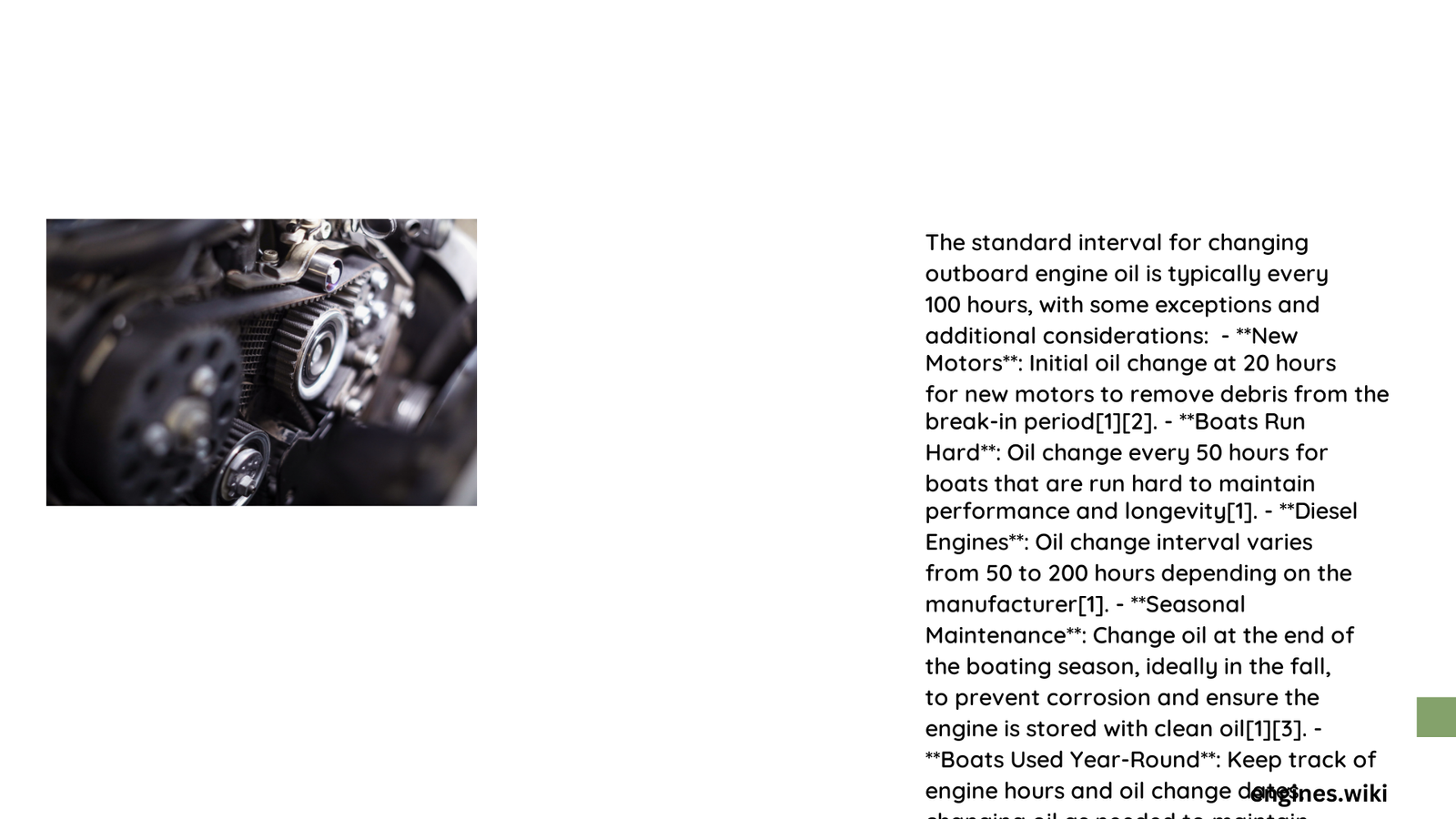Maintaining the right oil change schedule for your outboard engine is crucial for preserving its performance, preventing premature wear, and avoiding costly repairs. Boat owners must understand that oil change frequency depends on multiple factors like engine type, usage conditions, and manufacturer recommendations. Regular oil changes protect your marine investment by ensuring clean lubrication, reducing friction, and preventing potential engine damage.
What Determines Outboard Engine Oil Change Frequency?
Marine engines operate in challenging environments that demand precise maintenance. The standard recommendation for most outboard engines is changing oil every 100 hours of operation or annually, whichever occurs first. However, several critical factors influence this baseline interval.
Key Factors Affecting Oil Change Intervals
| Factor | Impact on Oil Change Frequency |
|---|---|
| Engine Type | Four-stroke vs. Two-stroke |
| Usage Intensity | Casual boating vs. Professional use |
| Operating Conditions | Saltwater, freshwater, temperature extremes |
| Engine Age | New vs. Older engines |
How Frequently Should You Change Oil for Different Engine Types?
Four-Stroke Outboard Engines
- Standard Interval: 100 hours or annually
- Break-in Period: First oil change at 20 hours
- High-Stress Conditions: Potentially every 50 hours
Two-Stroke Outboard Engines
- Standard Interval: 50-75 hours
- Synthetic Oil: Potentially extended to 100 hours
- Racing/High-Performance: More frequent changes
Critical Signs Your Outboard Engine Needs Oil Change

Recognizing when to change oil goes beyond strict hour measurements. Watch for these indicators:
- Visual Oil Inspection
- Dark, murky oil color
- Visible contaminants
-
Reduced oil transparency
-
Performance Indicators
- Decreased engine responsiveness
- Unusual engine noise
- Increased fuel consumption
-
Reduced acceleration
-
Mechanical Warning Signs
- Increased engine temperature
- Rough idling
- Metallic particles in oil during inspection
Best Practices for Outboard Engine Oil Maintenance
Recommended Oil Change Process
- Use marine-grade oil meeting manufacturer specifications
- Select correct oil viscosity for your engine
- Drain old oil completely
- Replace oil filter
- Use clean funnel to prevent contamination
- Check oil level after refilling
- Run engine briefly to circulate new oil
Seasonal Maintenance Considerations
- Winter Storage: Change oil before long-term storage
- Saltwater Use: More frequent oil changes
- High-Performance Boats: Monitor oil condition closely
Advanced Oil Change Strategies
Oil Analysis Programs
- Professional oil testing
- Extended change intervals
- Predictive maintenance approach
Synthetic Oil Benefits
- Longer service intervals
- Better temperature performance
- Enhanced engine protection
Common Mistakes to Avoid
- Ignoring manufacturer recommendations
- Using automotive instead of marine-specific oil
- Skipping break-in period oil changes
- Overlooking oil filter replacement
Cost-Benefit Analysis of Regular Oil Changes
| Maintenance Approach | Potential Savings | Risk Level |
|---|---|---|
| Irregular Changes | Low | High Risk |
| Manufacturer Recommended | Moderate | Low Risk |
| Professional Monitoring | High | Minimal Risk |
Final Recommendations
Consistently changing your outboard engine oil according to manufacturer guidelines and usage conditions is the most cost-effective strategy for long-term engine health. While 100 hours or annually serves as a general rule, always prioritize your specific engine’s needs and operating environment.
Pro Tip
Maintain a detailed log of oil changes, noting date, hours, conditions, and oil type for comprehensive engine tracking.
Conclusion
Proactive oil maintenance prevents expensive repairs and ensures your marine engine’s reliability and performance. By understanding how often to change outboard engine oil, you’re investing in your boat’s longevity and your maritime adventures.
